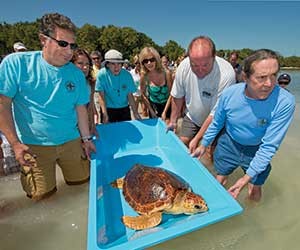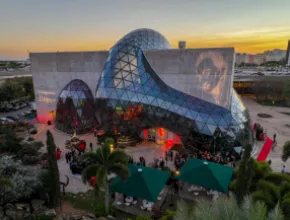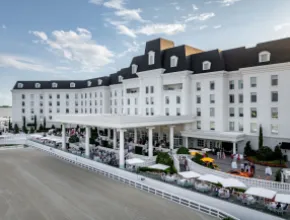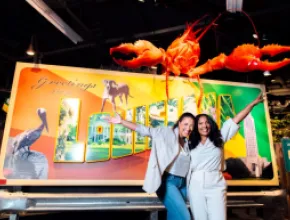The world may be full of reality checks, but there’s a place in Florida where you can check reality at the door—the Florida Keys.
Called “America’s Caribbean,” the Keys are a departure in more ways than one. They leave the mainland at the southeast border of the Everglades and never look back, creating a panorama of sea and sky that’s as hospitable to legions of birds and marine life as it is to visitors seeking an escape from…well, reality.
Not only is the entire 125-mile island chain a National Marine Sanctuary—protecting delicate coral reefs, seagrass beds, mangrove trees and countless species of aquatic creatures—it’s a nautical playground of world-class diving, swimming, snorkeling, boating and fishing. On dry land, visitors sail through the hours perusing one-of-a-kind boutiques and art galleries, watching spectacular sunsets and kicking back at bars and eateries that all seem to share the same design feature: incredible views of the Atlantic Ocean or Gulf of Mexico. This is the original Margaritaville.
Yet beneath its surface of fun and sun, the Keys are home to a rich stash of historical treasures that span the centuries, including literal gold and silver still lurking somewhere on the ocean floor, left behind by 17th century shipwrecks and awaiting modern discovery.
“There’s a lot of history here, but it’s not old and stuffy, it’s very hands-on and fun,” says Claudia Pennington, executive director of the Key West Art & Historical Society, which operates the Key West Museum of Art & History, the Lighthouse & Keeper’s Quarters Museum and the Fort East Martello Museum.
The Visionary
It’s impossible to talk about Keys’ history without mentioning one name: Flagler. By 1904, Standard Oil magnate Henry Morrison Flagler had already developed the resort cities of St. Augustine and Palm Beach, and extended his Florida East Coast Railroad to Miami. Then he set his sights on the Keys, sending construction crews in to build massive bridges and trestles in open water; on Jan. 22, 1912, Flagler rode the first train into Key West.
At the time hailed as an engineering marvel and the “Eighth Wonder of the World,” Flagler’s railroad proved to be no match for Mother Nature. In 1935, a hurricane destroyed the railroad beyond repair and it was never rebuilt, thanks in part to the rising popularity of the automobile. Within three years, the sturdy railway spans and specially constructed columns that had survived the storm became the foundation for the Overseas Highway, the southernmost leg of U.S. Highway 1 that once again connected the Keys to the mainland and each other.
The entire story plays out at the Key West Museum of Art & History at the Custom House, “the only place in Key West where you can learn the history of the island itself,” Pennington declares. “We have a wonderful interactive history exhibit that starts at the very beginning and takes you up to Flagler’s railroad. We’ve re-created a railroad car and have rare footage of the train.”
Meanwhile, an original FEC railway car filled with memorabilia is a highlight at Key West’s Flagler Station Over-Sea Railway Historeum.
The Wreckers
Of course, the history of the Keys started well before Henry Flagler noticed them. The islands were on the route taken by Spanish galleons to bring treasures from the New World back to the Old, but inclement weather and other mishaps, including pirate attacks, often intervened and sometimes these massive vessels—weighted down with gold, silver and jewels—sank outright or foundered on the reefs and sandbars.
Key West’s early development, in fact, was a direct result of frequent shipwrecks, as “wreckers” —those who rescued passengers and salvaged cargo—started a flourishing trade that drew new arrivals from locales as far flung as New England and the Bahamas.
“When Miami was still a swamp, this was a booming economy,” Pennington notes.
Groups can explore 400 years of salvaging history at the Key West Shipwreck Treasure Museum, where twice-hourly historical presentations feature actors in period costumes and artifacts include “pieces of eight” and a silver bar from a 1656 shipwreck, “though some people think it’s cursed,” warns Frank Bumstead, the museum’s supervisor, who also notes the facility is available for group rental after hours.
The Military
Meanwhile, the same strategic route along the Florida Straits that drew over 100 ships a day past Key West during the “golden age” of sailing also drew the U.S. military to the Keys during the Civil War. As a result, several strongholds were erected, including Fort East Martello, now a museum. Designed after the coastal watchtowers of Italy, Martello was built to withstand the firepower of the day, although it never actually went through a major battle.
Today, the fort’s well-preserved casements and citadel house a variety of military memorabilia and artifacts, though the site’s most popular item has no military connection whatsoever—Robert, the haunted doll, who once belonged to the child of an early Key West family.
“Robert has his own Facebook page, and we have a staff member who does nothing but answer Robert’s fan mail,” Pennington says.
Robert is also a prominent feature of ghost tours that stop at Martello, where, Pennington adds, “funny things happen every now and then.”
Less spooky but just as historically important is Fort Zachary Taylor—built in 1866 and now a state park—offering ranger-guided tours daily, which may be followed by snorkeling excursions from the park’s beach. Private group tours can be arranged in advance.
Meanwhile, a facility that started life as a naval command headquarters during the Spanish-American War has become one of the island’s premier group venues. The Truman Little White House—used by President Harry S. Truman from 1946-1952 and by six succeeding presidents—offers a small indoor meeting room and outdoor lawn space, while an expert event staff can help arrange corporate parties and other functions. Recent events included a croquet tournament on the lawn and a concert featuring Truman-era music. Smaller groups or VIPs can even dine at the 16-seat President’s Table or enjoy an evening of poker and bourbon, as Truman himself did there once.
“Presidents of corporations love to sit where actual presidents have,” says Robert Wolz, director of the venue. “Guests understand that they’ve been brought somewhere very important. We provide a very unique, exciting concept. It often has quite an impact on a group.”
The Treasures
By virtue of geography, Key West has most of the island chain’s heritage sites, though there are fascinating historical attractions throughout the Keys. Set beneath the old Seven Mile Bridge—built by Flagler for the railroad but replaced by a new structure in 1982—five-acre Pigeon Key once housed a railroad construction camp but today is open for tours and recreation. A classroom with audiovisual equipment is available for meetings, or groups can also rent out the entire island, says Kelly McKinnon, executive director of the Pigeon Key Foundation.
“We’ve done corporate retreats, church groups and marine science education groups,” he says.
Farther along the Overseas Highway in Islamorada, one of the Keys’ most popular pastimes is explored at the History of Diving Museum, boasting an extensive collection of diving helmets from around the world as well as a new, state-of-the-art research library that can host groups of up to 50.
In Key Largo, a touch of old Hollywood glamour is back. The African Queen, the iconic vessel from the 1951 Bogart-Hepburn film of the same name, has emerged from a restoration to once again cruise the waters off Key Largo. Built in 1912 and registered as a National Historic Site, the vessel runs sightseeing tours, or groups may charter it for private outings.
More on the Florida Keys






